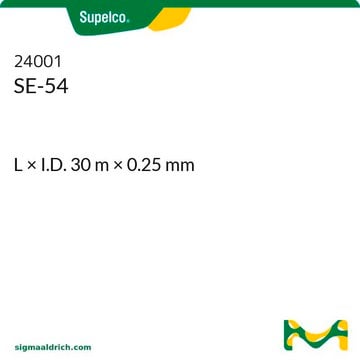25351
Colonna GC capillare SPB®-5
L × I.D. 60 m × 0.53 mm, df 5.00 μm
Autenticatiper visualizzare i prezzi riservati alla tua organizzazione & contrattuali
About This Item
Codice UNSPSC:
41115710
eCl@ss:
32119290
Prodotti consigliati
Materiali
fused silica
agenzia
meets requirements for USP G27 and G36
Parametri
-60-260 °C temperature (isothermal)
-60-280 °C temperature (programmed)
Beta
27
df
5.00 μm
tecniche
gas chromatography (GC): suitable
Lungh. × D.I.
60 m × 0.53 mm
Gruppo funzionale matrice
Bonded; poly(5% diphenyl/95% dimethyl siloxane) phase
Tipo di colonna
capillary non-polar
Cerchi prodotti simili? Visita Guida al confronto tra prodotti
Descrizione generale
Capillary GC column is also known as open tubular column. The carrier gas flows through the central aperture and is unrestricted throughout the length of the column.
Applicazione: Questa colonna non polare per scopi generali offre principalmente un ordine di eluizione secondo il punto di ebollizione con un piccolo aumento di selettività, specialmente per i composti aromatici.
Codice USP: questa colonna soddisfa i requisiti USP G27 e G36.
Fase
Codice USP: questa colonna soddisfa i requisiti USP G27 e G36.
Fase
- Legata
- Poli (5% difenile/95% dimetilsilossano)
- ≤D. I. 0,32 mm, <2 μm: da -60 °C a 320 °C (isoterma o programmata)
- ≤D. I. 0,32 mm, ≥2 μm: da -60 °C a 300 °C (isoterma o programmata)
- ≥D. I. 0,53 mm, <2 μm: da -60 °C a 300 °C (isoterma) o 320 °C (programmata)
- ≥D. I. 0,53 mm, ≥2 μm: da -60 °C a 260 °C (isoterma) o 280 °C (programmata)
Applicazioni
SPB®-5 Capillary GC Column was used for speciation of the nitrogen compounds (quantitatively), which are polar and somewhat basic in nature, with chemiluminescence detection. It may be used as stationary phase for determination of nivalenol and deoxynivalenol in cereals by electron-capture gas chromatography. It may also find application in being used as stationary phase in capillary column gas chromatography for determination of sterols.
Altre note
We offer a variety of chromatography accessories including analytical syringes
Note legali
SPB is a registered trademark of Merck KGaA, Darmstadt, Germany
Codice della classe di stoccaggio
11 - Combustible Solids
Classe di pericolosità dell'acqua (WGK)
WGK 3
Punto d’infiammabilità (°F)
Not applicable
Punto d’infiammabilità (°C)
Not applicable
Choose from one of the most recent versions:
Possiedi già questo prodotto?
I documenti relativi ai prodotti acquistati recentemente sono disponibili nell’Archivio dei documenti.
Determination of nivalenol and deoxynivalenol in cereals by electron-capture gas chromatography
SCott PM
Journal - Association of Official Analytical Chemists, 889-893 (1985)
Á Kenéz et al.
Journal of dairy science, 102(12), 11718-11729 (2019-09-30)
Adipose tissue response to endocrine stimuli, such as insulin, is crucial for metabolic adaptation at the onset of lactation in dairy cows. However, the exact molecular mechanisms behind this response are not well understood. Thus, the aim of this study
Development of a passive sampler to measure personal exposure to gaseous PAHs in community settings.
Zhihua Fan et al.
Environmental science & technology, 40(19), 6051-6057 (2006-10-21)
A sensitive, simple, and cost-effective passive sampling methodology was developed to quantify personal exposure to gaseous polycyclic aromatic hydrocarbons (PAHs). A Fan-Lioy passive PAH sampler (FL-PPS) is constructed from 320 sections of 1-cm long SPB-5 GC columns (0.75-mm i.d. and
J M Jurado et al.
Talanta, 106, 14-19 (2013-04-20)
4-Methylsterols and 4,4-dimethylsterols of 47 samples of subcutaneous fat from Iberian pigs reared on two different fattening systems, "Extensive" and "Intensive", have been analyzed by GC-MS and GC-FID. The lipids were extracted by melting the subcutaneous fat in a microwave
V Gajdůsková et al.
Veterinarni medicina, 37(8), 471-478 (1992-08-01)
Occurrence of individual polychlorinated biphenyl (PCB) congeners in the environment, foodstuffs and other biological materials was assessed. Analysis of specific PCB congeners (28, 52, 101, 138, 153, 180), occurring in animal raw materials and foodstuffs most frequently, has been implemented.
Il team dei nostri ricercatori vanta grande esperienza in tutte le aree della ricerca quali Life Science, scienza dei materiali, sintesi chimica, cromatografia, discipline analitiche, ecc..
Contatta l'Assistenza Tecnica.




